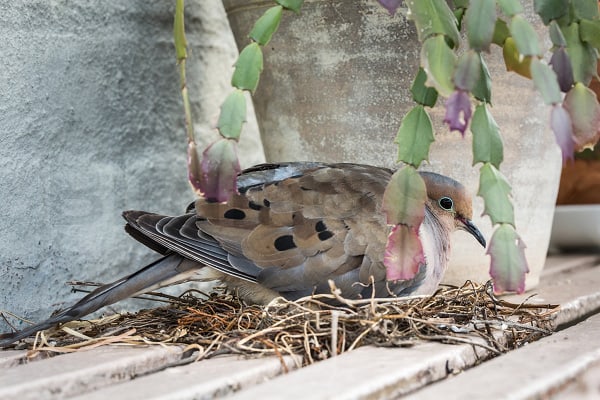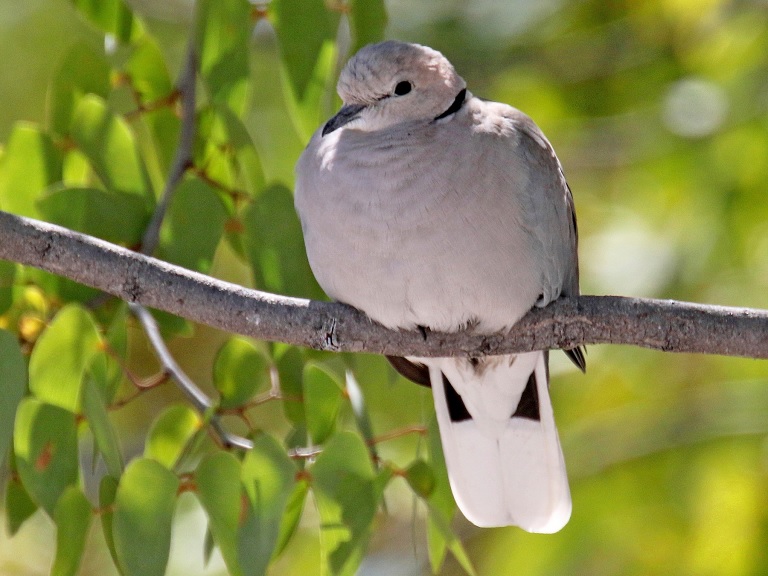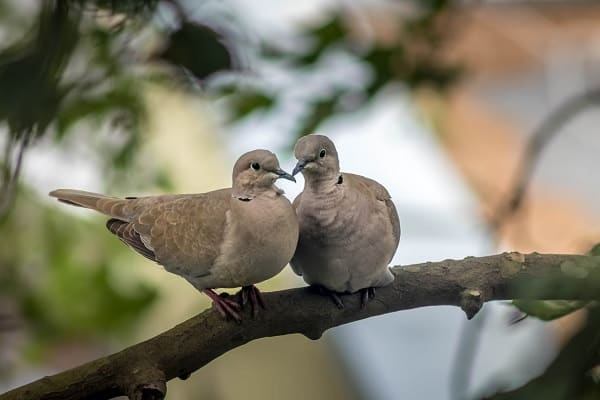Doves in Michigan are beautiful and gentle birds that live in various habitats. You can find four common species of doves across the state, each with its distinctive features and behaviors. In this post, I will share some images and tips on how to identify these doves and appreciate their presence.
What Kind of Doves Are in Michigan?
Michigan hosts a mix of native and introduced dove species. Let’s explore each of them in more detail:
1. Mourning Dove
Do you love waking up to the sound of birdsong? If you live in Michigan, chances are you’ve heard the soft and soothing cooing of the mourning dove. This graceful bird is a common sight in the countryside, where it brings peace and beauty to the landscape.

Mourning doves are not only lovely to look at, but they also have a fascinating life story. In this article, you’ll learn how to identify them, where to find them, and what they do throughout the year. You’ll also discover some amazing facts about these gentle songbirds that will make you appreciate them even more.
How to Identify Mourning Doves?
Mourning doves are easy to recognize by their slender shape, grayish-brown color, and black spot on their neck. They are small birds, about the size of a robin, with a long tail and pointed wings. Here are some more details to help you identify them:
- Size: Mourning doves are about 9-13 inches long, with a wingspan of around 17 inches.
- Color: Mourning doves have a light grayish-brown body, with a pinkish hue on their chest. They have black spots on their wings and a black teardrop-shaped spot on their neck. Their eyes are dark, with a thin blue ring around them. Their beak is short and black, and their feet are pink.
- Sound: Mourning doves make a distinctive cooing sound, often repeated several times. It sounds like “coo-ah, coo, coo, coo.” Some people find this sound sad or mournful, while others find it calming and relaxing.
Mourning doves are usually seen in pairs or small groups, near open fields, woodlands, and suburban areas. They are migratory birds, which means they travel to warmer places in the winter. But some of them stay in Michigan all year round.
Must Read: Types of Doves in Arizona
2. Rock Pigeon
Have you ever wondered how pigeons manage to live in the city? They are everywhere, from the rooftops to the sidewalks, coexisting with humans and cars. But these pigeons are not just ordinary birds. They are survivors, who have adapted to the harsh and changing environment of the urban jungle.

In this article, you’ll learn more about the Rock Pigeon, the most common pigeon species in Michigan. You’ll discover how they look, where they live, and what they do. You’ll also find out some surprising facts about these amazing birds, which have a history that goes back thousands of years.
How to Identify Rock Pigeons?
Rock pigeons are easy to spot by their size, color, and behavior. They are slightly larger than Mourning Doves, with a wingspan of up to 26 inches. They have a grayish-blue body, with shiny patches on their neck that change color in the light. They also have black bands on their wings and tail.
Rock pigeons are often seen in groups, perching on buildings, ledges, and bridges. They are very adaptable, and can live in almost any urban setting. They are also very social, and communicate with each other using different sounds and gestures.
Related Article: Doves in Hawaii: 4 Beautiful Species
3. Ring-necked Doves: Invasive Species
Have you noticed a new bird in your backyard or garden? It might be a Ring-necked Dove, an exotic species that has invaded Michigan. This dove is not only beautiful but also controversial. Why is it here, and what does it mean for native wildlife? Read on to find out.

What Does It Look Like?
Ring-necked Doves are about the same size as Mourning Doves, which are common in Michigan. They are light gray all over, except for a black ring around their necks. They make soft, cooing sounds during the day.
Where Does It Come From?
Ring-necked Doves are native to Africa, where they live in dry savannas and woodlands. They were introduced to North America as pets, but some escaped or were released into the wild. They have adapted well to urban and suburban areas, where they find food and shelter near humans.
Why Is It a Problem?
Ring-necked Doves are considered invasive because they compete with native birds for resources. They eat seeds, fruits, and grains, which are also the main food sources for many native birds. They can also spread diseases and parasites to other birds. They have no natural predators in Michigan, so their population can grow rapidly.
What Can You Do?
If you see a Ring-necked Dove in your area, you can report it to the Michigan Department of Natural Resources. You can also help native birds by providing them with clean water, native plants, and birdhouses. Avoid feeding Ring-necked Doves, as this will encourage them to stay and breed.
Related Article: Ducks in Michigan
4. Eurasian Collared Doves in Michigan
Have you ever noticed a new bird in your backyard that looks like a dove, but has a black ring around its neck? If so, you might have encountered a Eurasian Collared-Dove, a foreigner who has quietly settled in Michigan. But how did this bird get here, and what does it mean for the native birds of Michigan? In this article, we will explore the fascinating story of this introduced dove and its surprising role in the ecosystem.

How to Identify the Eurasian Collared-Dove
The Eurasian Collared-Dove is not a native bird of Michigan. It is originally from Asia and Europe, and has spread to many parts of the world. It is often confused with the Mourning Dove, which is a common and native bird of Michigan. Here are some ways to tell them apart:
- Size: The Eurasian Collared-Dove is slightly larger than the Mourning Dove, measuring about 12-14 inches in length.
- Color: The Eurasian Collared-Dove has a light grey body with a distinctive black “collar” on the back of the neck, which sets it apart from other dove species.
- Sound: The Eurasian Collared-Dove has a different cooing sound than the Mourning Dove. It consists of a series of coos, while the Mourning Dove has a single coo followed by a whistling sound.
You can see and hear the difference between the two doves in this video.
How the Eurasian Collared-Dove Arrived in Michigan
The Eurasian Collared-Dove has a remarkable history of colonization. It is believed that the bird originated in India and expanded its range to Europe and Asia over centuries. However, the most dramatic expansion occurred in the last century, when the bird invaded North America.
The story goes that in the 1970s, a pet shop in the Bahamas received a shipment of Eurasian Collared-Doves from Europe. Some of the birds escaped during a burglary and established a wild population on the islands. From there, the birds spread to Florida and then to the rest of the continent.
The first record of the Eurasian Collared-Dove in Michigan was in 2002, in Monroe County. Since then, the bird has been spotted in many counties across the state, especially in the southern and eastern regions. You can see the distribution map of the Eurasian Collared-Dove in Michigan here.
How the Eurasian Collared Dove Affects the Native Birds of Michigan
The Eurasian collared dove is a very adaptable bird that can live in a variety of habitats, from urban to rural areas. It feeds on seeds, grains, fruits, and insects, and can nest on buildings, trees, or power lines. It is also very prolific, breeding up to six times a year and producing two eggs per clutch.
But does this mean that the Eurasian collared dove is a threat to the native birds of Michigan? The answer is not so simple. On one hand, the Eurasian collared dove may compete with the native doves and other seed-eating birds for food and nesting sites. It may also attract predators, such as hawks and falcons, that may prey on the native birds as well. On the other hand, the Eurasian collared dove may provide some benefits to the native birds, such as serving as a food source for predators or acting as a decoy for hunters.
The impact of the Eurasian collared dove on the native birds of Michigan is still unclear and needs more research. However, one thing is certain: the Eurasian Collared-Dove is here to stay, and we need to learn more about this intriguing newcomer to our avian community. If you’re interested in learning more about the Eurasian Collared Dove, a common invasive species in Michigan, you can find additional information on the official Michigan government website.
Frequently Asked Questions
Q1: Are doves common in Michigan?
Yes, doves, particularly Mourning Doves, are common throughout Michigan. You can spot them in a variety of habitats, from open fields to city parks. Their prevalence makes them a delightful addition to the state’s avian landscape.
Q2: Is there a dove season in Michigan?
Yes, Michigan has a dove hunting season, typically in early September. This season allows hunters to pursue these birds as part of the state’s wildlife management efforts. Hunters are required to follow state regulations, including obtaining the appropriate permits.
Q3: Do doves migrate from Michigan?
Some dove species, like the Mourning Dove, are migratory and may leave Michigan in the winter. They migrate southward in search of warmer climates and return in the spring. However, other dove species, like the Ring-necked Dove and Eurasian collared dove, are year-round residents and do not undertake long-distance migrations.
Q4: What states have no dove hunting?
While dove hunting is popular in many states, there are a few states where it is not allowed due to various reasons, including conservation efforts. These states include Hawaii, Washington, and New Jersey. It’s important to check the specific regulations and hunting seasons in your area.
